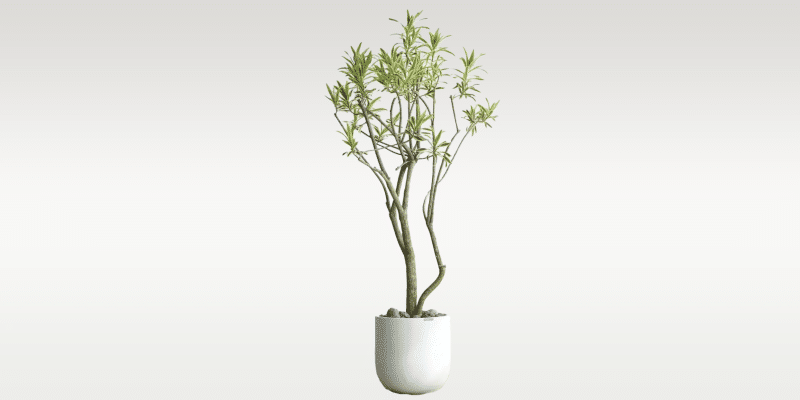The Dracaena reflexa plant, or Song of India, is a common ornamental houseplant that comes in a range of beguiling varieties. Looking for dark green leaves with red edges? Yellow stripes more your style? This tropical plant has it all.
Besides boasting colorful leaves, Dracaena reflexa even purifies the air around us (thanks NASA)!
Dracaena reflexa is a resilient, low-maintenance addition to any home or office that doesn’t need to be repotted for years. We’ll explore how to care for your Dracaena Reflexa, its ideal environment, and some of the most eye-catching variants available.
Table of Contents
Dracaena Reflexa Care Guide
History, habitat, and characteristics
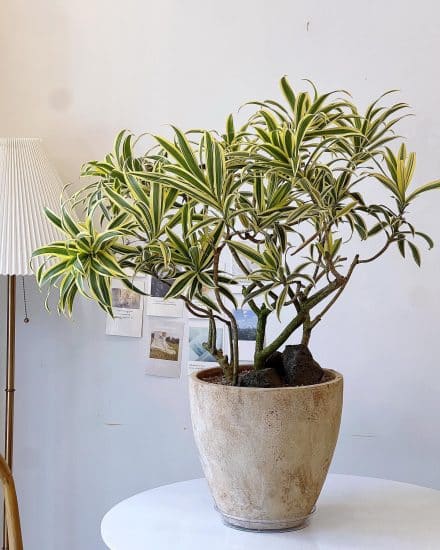
Dracaena reflexa, previously called Pleomele reflexa, is a tropical house plant first described by French naturalist and biologist Jean-Baptiste Lamarck in 1786. Its scientific name comes from a combination of the Greek word drakaina, meaning “female dragon,” and the Latin word reflexa, meaning “bent downward.”
Originating from Mauritius, Madagascar, and other Indian Ocean islands, this plant is also called reflexed dracaena, Dracaena reflexa “Song of India,” or “Song of Jamaica,” depending on who you ask. A 2018 article from Oryx—The International Journal of Conservation could help explain these differing names. It noted the plant isn’t monophyletic, meaning it didn’t descend from one common ancestor.
This means that the Dracaena reflexa we all know and love could belong to more than one species, since, for instance, reflexa plants from Mauritius have different evolutionary characteristics from those in Madagascar. Neat!
Outdoors, Dracaena plants typically reach heights of up to 20 feet. Indoors, this member of the Asparagaceae family grows much more slowly, never getting more than around five feet tall and five feet wide.
But don’t worry, they won’t take over your home! Growing at a rate of only 3-4 inches per year, these plants can last for decades in the same pot if given proper care, and it can take five to 10 years for them to reach full height.
Visually, Dracaena reflexa can vary in shades of glossy deep green to yellow-green and white-striped foliage. Its dark green, narrow pointed leaves are arranged in a rosette-like pattern and resemble a cluster of stars. Individual leaf blades can grow around a foot tall and a few inches wide. Stems are thick with multiple irregular branches.
Dracaena plants bloom rarely in winter after a few years, with small, five-petaled, clustered white flowers that smell delightful. After the flowers come orange-red berries.
NASA notes that Dracaena reflexa remove airborne toxins and pollutants like benzene, trichloroethylene, and formaldehyde from the air. It adds style and provides a useful air filtration system all in one—what a plant!
Dracaena Reflexa Variegations
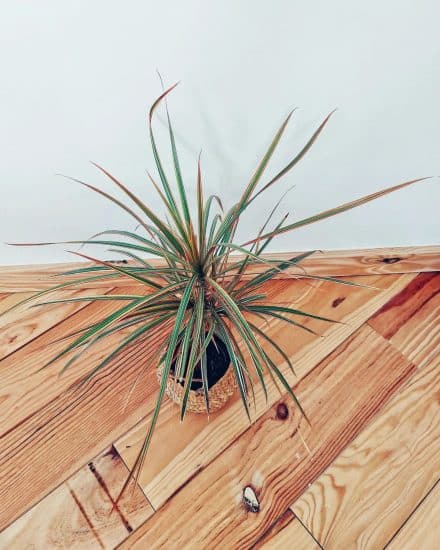
While there are 13 Dracaena reflexa variations as of this writing, two are the most popular:
- Dracaena reflexa var. angustifolia or Dracaena marginata: Commonly known as Red Edged Dracaena or the Madagascar dragon tree, this variant has long green leaves lined with red on the sides and produces flowers with a magenta hue.
- Dracaena reflexa ‘Variegata’: This plant sports green young leaves with a lime-yellow margin at first, growing to achieve a lighter green color with creamy striped sides. It was given the Award of Golden Merit from the Royal Horticultural Society.
Did you know: This plant is one of 120 Dracaena species of succulent shrubs and trees. Dracaena reflexa is related to Dracaena fragrans, or the corn plant. They’re both from the same Dracaena genus and are both common house plants.
Light
Dracaena reflexa is a low-maintenance houseplant that doesn’t require a lot of light to thrive. Make sure to give it bright, indirect light, as it may be damaged from too much direct sunlight.
To ensure optimal growth, keep the plant at least a few feet away from windows facing South and West, which both allow direct bright light, or hang a sheer curtain to diffuse it. This plant can also survive in dimly-lit rooms with low light conditions; however, this may stunt its growth.
To tell if your Dracaena reflexa is not receiving enough light, look out for signs like leggy growth (this is called etiolation as it reaches for the sun), discoloration, and faded leaves. On the other hand, too much light can cause damage to the leaves, such as scorched blade ends or yellow tips. In this case, reposition your Dracaena reflexa away from direct sunlight, or farther away from the window if necessary.
If the light is only moderately bright but your Dracaena is is still brown or yellow, you may need to increase your watering frequency instead.
Water
Speaking of watering frequency, while Dracaeana reflexa is drought-tolerant, it does still need to be watered on occasion. Keeping your Dracaena Reflexa slightly on the drier side is ideal. This plant fares much better when slightly underwatered rather than overwatered.
When it comes to watering your India plant, the best approach is to wait until the top two inches of your potting soil is dry. Then, water your plant thoroughly until water runs out the bottom of the pot. You want the soil moist but not sopping wet. In the warmer months, you may need to water your Dracaena Reflexa once a week to every two weeks, while in the cooler months, once every two to four weeks should suffice.
If the temperature is above 85°F or the plant is in direct sunlight, water frequency might need to change, but don’t let it get to the point of overwatering! This can cause leaves to yellow, curl and develop brown spots at the base. On the other hand, if Dracaena Reflexa leaves begin to wilt, you’re likely underwatering, so give it a good soaking.
While you can use tap water, the chemicals it contains might not be the best for your plant’s growth. If you have the option, try to use filtered or distilled water, or even collected rainwater.
Temperature and humidity
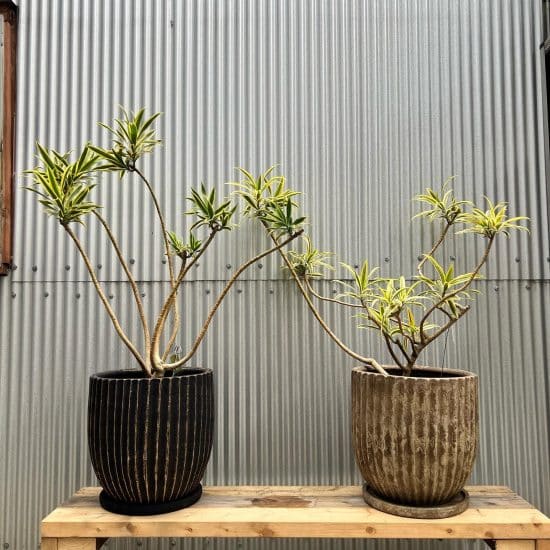
Dracaena reflexa grows in US Zones 10B through 11 and prefers normal room temperatures between 65-80 degrees Fahrenheit. Take care not to keep it in an unheated room or near a gusty window, since it dislikes cold drafts, and temperatures below 55 degrees Fahrenheit will damage the plant.
Ideal humidity levels for the Dracaena reflexa are between 40-60%.
If your home tends to be dry, you can:
- Use a humidifier or a pebble tray to help raise humidity levels around your plant
- Put it in a bathroom or kitchen with more humidity as long as there is adequate light
- Group plants with similar humidity requirements together (they share humidity via transpiration)
If you plan on placing your plant outdoors at any point during the year, ensure that it has access to part shade to protect it from becoming too warm.
Soil and planting
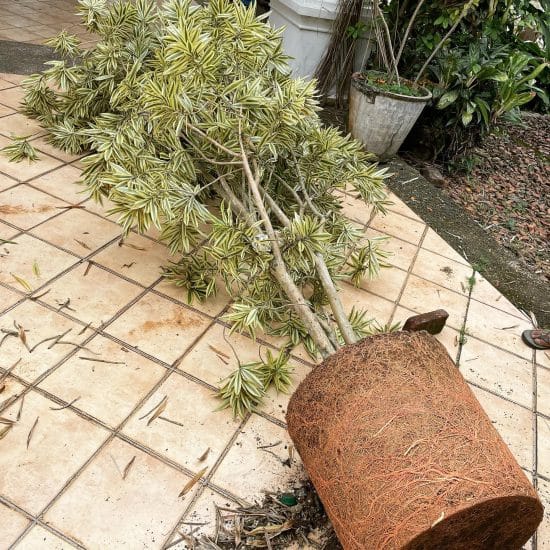
Dracaena reflexa needs a light and well-draining soil mix in order to provide its delicate root system with access to air and prevent root rot. Its ideal soil should have a pH range of 6.5 to 7.5, and contain:
- 70% All-Purpose Potting Mix: Ensures good drainage and gives roots access to air.
- 10% Perlite or Coarse Sand: Provides fast drainage and keeps the soil loose.
- The remaining 20% of the potting medium can be a mixture of your choice. Throw in a combination of LECA or orchid bark to further improves soil aeration and drainage. If your mix needs more water retention, add some perlite or pumice. Boost its nutrient level with coco coir, peat moss, sphagnum moss, or vermicast.
Basically, any ingredient combination that’s at least one part houseplant soil, retains moisture, and doesn’t leave your Song of India sitting in soggy soil is the way to go.
Fertilizing
Dracaena plants should be fertilized on a regular basis while they’re actively growing during the spring and summer months with a 50% diluted balanced liquid houseplant fertilizer. Like other house plants, it goes dormant during the winter, so don’t fertilize it then, since this can cause wilting or scorched plant leaves.
Pruning
If you notice a yellow stem, or cane, use a clean pair of pruning shears to cut it at the base or remove the entire stem. You can also cut unruly stems to a specific length of your choice to shape the plant, since it will continue to grow afterward. Pruning your plant will help it produce new stems and become bushier.
Repotting
You won’t have to repot a Dracaena plant often, as it grows slowly and can thrive in the same pot for years on end. When it is time to give your Dracaena reflexa a new pot, however, it’s important to use the soil mix described above and give the plant plenty of room to grow.
Select a wide, shallow pot several inches larger than the previous one with adequate drainage holes. Additionally, be sure to allow extra access to sunlight for a few days after repotting.
Enough about environmental needs—let’s learn how to propagate this common houseplant!
Propagation guide
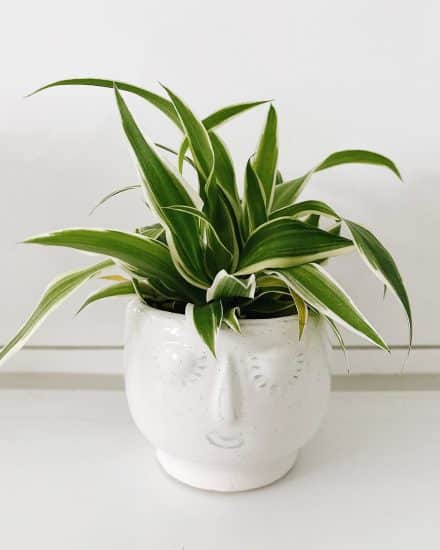
Propagating a Dracaena reflexa plant is a great way to share its beauty with friends and family, or just increase your own collection. Stem cuttings in soil and water, as well as air layering in sphagnum moss, are the quickest and easiest ways to propagate this plant.
Which to choose?
Water propagation is typically faster than soil propagation, but the resulting roots can be weaker and have a harder time adjusting to soil when they are transplanted.
Soil propagation sometimes takes longer than water propagation, but roots are stronger and there is no need to transfer between mediums.
Sphagnum moss propagation offers better air and moisture control, as well as faster root development, but it is a little bit more involved than the other two options. We’ll go over the soil and water methods here.
To propagate Dracaena reflexa by stem cuttings:
- Carefully cut a 4-6 inch long stem with at least five leaves from a healthy plant with clean shears or a sharp knife. Cut away the lower leaves from the stem cuttings, exposing the nodes from which the root will grow.
- If propagating by soil, dip the cut end of the stem into plant rooting powder (optional). Place your cutting into a small pot along with your potting mix (it should drain well).
- If propagating by water, place the stem into a glass jar or cup and fill it with clean, filtered water so the leaf nodes are submerged, but not the leaves.
- Locate the pot in an area with bright, indirect light. For soil propagation, make sure to keep the stem cutting moist but not soggy. After a few weeks, you should start to see roots growing.
- With water prop, once roots are two inches long, move your cutting into a larger pot with fresh potting soil.
With both soil and water propagation methods, care for the newly propagated reflexed Dracaena just like with the mother plant, giving it plenty of bright indirect light.
And that’s it! You’ve propagated your very own Song of India.
Now that you’re well-versed in propagating this common ornamental plant, time to tackle common issues and diseases.
Common issues
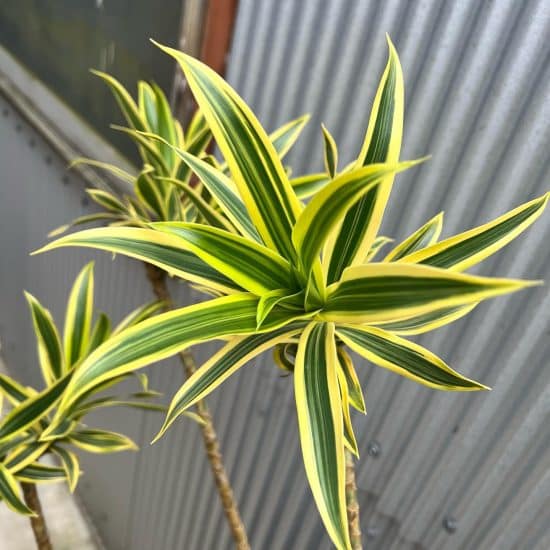
While the reflexa plant is fairly hardy, sometimes the amount (or type!) of sun or water it’s getting needs to be switched up. I’ll let you know how to tell there’s a problem and what to do about it.
Browning Leaves: Brown leaves may indicate the plant is getting too little or too much water, or too little or too much sunlight. Brown leaf tips can be caused by salt build-up in the soil. Put on your detective hat to figure out the most likely cause in your situation.
If it’s a water issue, let the soil thoroughly dry out between waterings, and consider switching to distilled or filtered water if you currently use tap water. If it’s a light issue, make sure your reflexa plant receives enough bright indirect sunlight and is at least a few feet away from any window with direct sun.
Yellow Leaves: Yellowing of Dracaena Reflexa’s leaves often occurs due to too much sunlight or overwatering. Yellow leaves can also be due to mineral buildup in the soil.
If you suspect it’s a light issue, move the plant to a spot that receives only indirect or filtered light. If it’s more likely a water issue, make sure to use a porous, nutrient-rich potting mixture with good drainage, and a pot with a drainage hole. This way, your plant’s roots can get oxygen.
Leaf Spotting: This can be caused by too much direct sunlight and extreme temperatures. To prevent this you can move your plant to an area that receives indirect light and check the room temperature to make sure it’s not too hot or too cold for the plant. You’ll also want to check for pests like mealybugs as they’re a common cause of leaf spotting.
Drooping or Wilted Leaves: usually means it’s time for a drink. Carefully inspect the soil for moisture, and if the soil looks soggy, it might need more aeration.
If the leaves are wilted, spotted, and yellow it can mean both too little water and too much sunlight. This could also indicate an issue with the roots. Give your plant some extra care and keep a lookout for root problems.
Diseases and pests
Dracaena reflexa can suffer from the usual plant diseases that affect many other indoor plants, but because they’re so common, they have tried and true solutions.
Fungal Diseases: Dracaena reflexa is prone to certain fungal diseases such as root rot, fusarium leaf spot, and powdery mildew. These conditions can be caused by excess water or inadequate drainage. If you notice yellow or brown leaves, leaf drop, and mushy or rotten roots, a fungal infection is likely.
- Root rot: Can cause leaves to turn brown or yellow, leaf drop, and mushy or rotten roots.
- Fusarium leaf spot: Occurs over fairly large areas of the plant, mostly on older leaves, as water-soaked lesions with brown/purple margins.
- Powdery mildew: Also known as oidium, powdery mildew has a white, fluffy appearance with yellow spots appearing on both sides of the leaf.
In any of these cases, isolate the plant from others to prevent fungal spread and take action immediately. For root rot and fusarium leaf spot, fungicidal treatments are recommended, but it’s also possible to cut off the affected parts and dispose of them properly. To prevent a reoccurrence, water plants at the base, ensure adequate pot drainage, and avoid getting water on your plant’s leaves.
If you notice powdery mildew on your plant, remove any affected leaves and disinfect any tools that were used to remove them. Use a fungicide spray sparingly. In the future, water less and make sure that the soil has time to dry out completely between waterings.
Pest Issues: Even though Dracaena reflexa are difficult to infiltrate, it’s possible for winged insects and other pests to find their way in. Look out for fungus gnats, scale, spider mites, whiteflies, aphids, and mealybugs. These pests are usually found in the undersides of the leaves. Sticky leaves or bits of white webbing are a sure sign pests are settling in.
Isolate the plant and treat it right away if you suspect there are bugs present. If you spot any of these unwelcome critters, it’s time to break out either the insecticidal soap or neem oil.
Conclusion
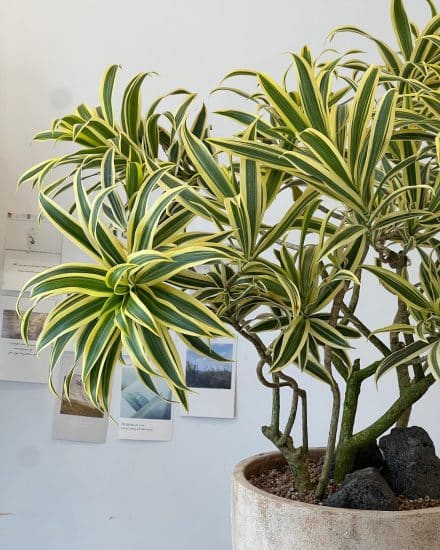
With its colorful varieties and air-cleansing properties, Dracaena Reflexa makes a wonderful add-on to any office space or home. Plus, it rarely needs regular pruning and repotting, as long as its soil is kept moist.
Give it the indirect bright light, normal household temps, and 40 to 60% humidity levels it needs to thrive, and you’ll have a healthy Dracaena plant adorning your home for years. Propagate it via stem cutting in soil or water and share the plant wealth with your friends—they’ll appreciate its easygoing nature too.
If you found this article useful, consider sharing it with a fellow reflexa plant owner. And as always, hit us up with any questions on Facebook or Twitter!
FAQ
Is Dracaena reflexa an indoor plant?
They’re both outdoor and indoor plants. As an outdoor plant, the reflexa plant can be pruned to serve as a garden hedge. When grown indoors, it works well as an accent plant to liven up a living room or office.
Is Dracaena Reflexa toxic?
According to the ASPCA, Dracaena reflexa plants are toxic because of the calcium oxalate crystals their stems and leaves produce, so be sure to keep them away from pets and small humans.
How big does Dracaena reflexa get?
While they can grow up to 20 feet outside, reflexa plants don’t usually have more than a five foot height and spread inside.
Sources
- https://www.rhs.org.uk/plants/102124/i-dracaena-reflexa-i-variegata-(v)/details
- https://powo.science.kew.org/taxon/urn:lsid:ipni.org:names:534338-1
- https://edis.ifas.ufl.edu/publication/FP187
- https://www.rhs.org.uk/plants/pdfs/agm-lists/agm-ornamentals.pdf
- https://www.missouribotanicalgarden.org/Portals/0/CCSD/Documents/Edwards%20et%20all-2018.pdf
- https://www.aspca.org/pet-care/animal-poison-control/toxic-and-non-toxic-plants/dracaena

